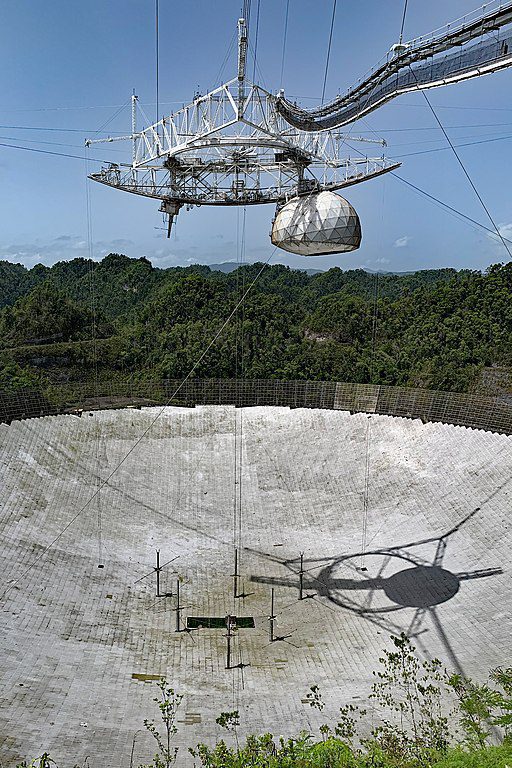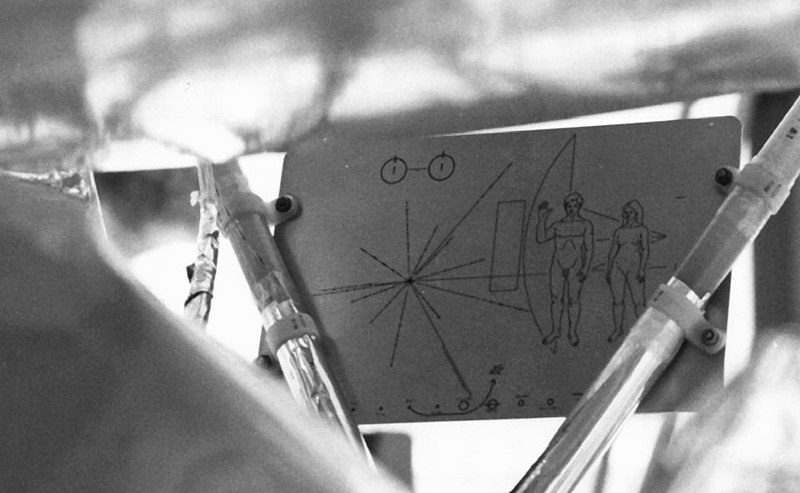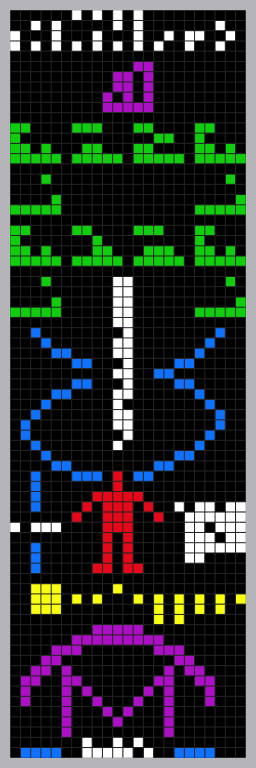For many decades now, researchers with the search for extraterrestrial intelligence—SETI, for short—have carefully scanned the skies for alien radio signals, undertaking a long and patient search for some proof that we are not alone in the cosmos. So far, their efforts have been inconclusive. When looking into deep space, we hear nothing, aside from the ordinary chatter of noisy stars and distant galaxies. Where is everyone? Are we without extraterrestrial neighbors? Or do they just not want to talk to us?
For our part, we have not answered silence with silence. Our species has taken the initiative, broadcasting our signals far into space, and not just as the accidental byproduct of television transmissions—in 1974, a team of researchers used the world’s largest radio telescope to send a greeting to extraterrestrial life, broadcasting a powerful signal towards a star cluster 25,000 light-years away.
This is the story of the Arecibo message.
The Arecibo observatory
The Arecibo radio telescope was built in 1963 near Arecibo, Puerto Rico, representing a major advancement in the field of radio and radar astronomy. Today, it is no longer in operation—hurricane damage and declining funding led to a structural collapse in December 2020, destroying the dish—but for many decades, it was a key scientific instrument, put to work on tasks as diverse as listening in on pulsars and measuring the rotation of Mercury. Its most visible component was an enormous, bowl-shaped reflector, placed snugly inside a natural sinkhole. Far overhead was an instrument-laden platform, suspended by cables, which could aim the telescope by moving around above the dish.

While the Arecibo observatory was a sensitive receiver, it could function as a transmitter, too. This was very useful for radar astronomy—it would send radio signals at other objects in the solar system, then listen for the echoes. It also meant that the telescope was the world’s most powerful instrument for contacting extraterrestrial beings.
In 1973, the Arecibo telescope received a major upgrade, trading its original wire-mesh surface for brand-new aluminum panels. A ceremony was planned in celebration of this achievement. For the occasion, researchers wished to demonstrate its immense transmitter energy with a directed deep-space signal, intended to be picked up and decoded by civilizations in distant star systems—no small task. What, exactly, would they say?
Drake and Sagan
The masterminds behind the Arecibo message were two famous figures in the world of astronomy: Frank Drake, and Carl Sagan. Drake was a radio astronomer who had played an instrumental role in starting the search for extraterrestrial intelligence. He was the author of the eponymous Drake equation, a multi-variable formula which purports to calculate the number of other civilizations active in the galaxy, and he also spearheaded the first serious efforts to listen for radio transmissions from potential galactic neighbors.

While you may not have heard of Frank Drake, you’ve almost certainly heard of Carl Sagan. A true titan of science, he played countless roles over his long and fruitful career—planetary scientist, science communicator, Cornell university professor, and host of the show Cosmos, just to name a few. Like Drake, he was deeply interested in SETI; the two men were frequent collaborators.

Messages beyond the Solar System
Prior to the Arecibo message, Drake and Sagan had worked together on the Pioneer plaques, which were identical metal engravings sent outside the Solar System aboard NASA’s Pioneer 10 and 11 space probes. These were simple designs, intended to communicate some basic ideas to aliens with no knowledge of Earth languages. There were human figures, male and female, along with a diagram of the Pioneer spacecraft, and a map of the Sun relative to several prominent stars. It was hoped that if extraterrestrial civilizations someday found the Pioneer probes, they could interpret their meaning and learn something about humanity.

The Arecibo message presented a similar challenge. This, too, had to be decipherable across the widest conceivable language barrier—if you were a squid alien from the far end of the galaxy, how would you interpret an alien radio message?
An interstellar Rosetta Stone
The Arecibo message consists of several sections, written in binary code. The binary digits were meant to be arranged together to form a tall image, containing some basic information about humanity—this image is reproduced below, with color coding that was not present in the original sequence. At the very top are representations of the numbers one through ten. Next, in purple, are the atomic numbers of elements present in human DNA: hydrogen, carbon, nitrogen, oxygen, and phosphorus. Moving up a level in complexity, the message then describes the chemical data of DNA nucleotides, using the elements previously specified; those are the green shapes in the image.
The blue curves represent a DNA double helix, while the white bar in the middle indicates the number of base pairs in the human genome. Directly beneath the double helix is a figure of a human—admittedly not the most detailed depiction, but hopefully enough to get across our basic body plan with two legs, two arms, and a head. To the right is the number 4.3 billion, which was the population of Earth in 1974. To the left is the average height of a human male, represented as the number 14. This was supposed to be multiplied by the wavelength of the message, 126 millimeters, to derive the actual value of 1.764 meters—though that would, of course, be rendered in whatever units were used by the alien listeners.
Below the stick figure, the message attempted to communicate the layout of the Solar System, with the Sun and its planets rendered very roughly to scale. The dot for Earth is raised, showing that it’s our homeworld. Finally, the Arecibo message concludes with an image of the antenna that sent it—a curve, shown in purple, depicts the reflector dish, and the binary digits at the very bottom indicate the width of the Arecibo telescope, again expressed in terms of the signal’s wavelength. The symbol that looks like an M is really a depiction of photons, bouncing off the curved mirror and into space.
To summarize: “This is what we’re made of. This is who we are. This is where we are. And this is how we contacted you.”

Cluster M13
Over a period of three minutes on November 16, 1974, the Arecibo message was broadcast in the direction of the globular cluster M13, which is about 25,000 light-years from Earth in the constellation Hercules. It is a spherical agglomeration of more than 300,000 stars, only 165 light-years across. M13 is packed incredibly tightly; compared to our own stellar neighborhood, the core of a globular cluster is a hundred times denser. This would make for incredible views—if you visited a planet in a globular cluster, the night sky would teem with enormous red and yellow stars, each as bright as Venus is to us. The alien landscape around you would never appear darker than twilight.

For the authors of the Arecibo message, the M13 globular star cluster was largely a target of convenience. Relative to the observatory, it happened to be in the right place in the sky, at the right time, and as a large, dense grouping of stars, there was a decent chance that an intelligent civilization would be on the other end to receive it. However, they did not account for the star cluster’s orbital motion around the Milky Way galaxy; in 25,000 years, when the message reaches its destination, M13 will have moved significantly, and the signal will graze its outer regions instead of passing through the center.
Consequences and controversy
Not everybody thought it was a good idea to send the Arecibo message. Actively broadcasting to alien civilizations is very different from our usual approach of just listening in—it is sometimes called “active SETI,” or METI, for “Messaging Extraterrestrial Intelligence.” Some, such as Stephen Hawking, have maintained that the signal we sent in 1974 was gravely irresponsible, perhaps even opening up humanity to extinction.
According to some theories, any spacefaring civilizations will respond to news of our existence not with open arms, but with military force. Did we inadvertently doom ourselves by sending signals into space? It is certainly not something to be done lightly. The SETI Institute recommended in 2015 that any METI efforts should take place after consultation with the entire global community, not just on the initiative of a few curious scientists; this was an implicit rebuke of the Arecibo message.
A reply?
There is another interesting coda to this story. In 2001, a crop circle appeared in a field near the Chilbolton Observatory in the United Kingdom, apparently spelling out an alien reply to the Arecibo message. It was, indeed, an almost exact replica, duplicating the format in trampled wheat—except the biochemistry was different, and the figure in the middle was an alien with a bulbous forehead.

There has been no real response, of course. The message was only broadcast 48 years ago, so it has not traveled far—and there would be no reason for technologically advanced aliens to respond with a crop circle, anyway. The supposed “reply” was the work of admittedly industrious and creative pranksters.
The search goes on
The Arecibo message was the first of its kind—a high-power transmission into deep space, formatted specifically so that alien intelligence might decode it. We don’t know if anyone will be on the other side, when it arrives in M13 25,000 years from now; almost certainly, we will never receive a response. Nevertheless, there is something awesome in the knowledge that there is a human signal out there, formulated by human minds, hurtling deeper into parts unknown with every passing year.


